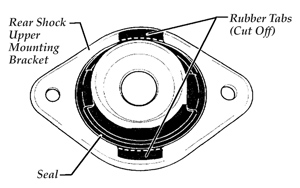Customers may use the term “vehicle pull” to describe a number of different potential incidents. The following diagnostic and repair information is specific to steering pull.
In a steering pull situation, the vehicle consistently drifts to one side while driving at a constant speed (60 mph) on a straight, flat road. A vehicle is said to pull if it completes a lane change in less than seven seconds with no steering correction from the driver when driving (at 60 mph) on a crown-sloped road of less than 1 percent. All four wheels must pass into the other lane during this time (seven seconds).
Pull can occur as a result of incorrect wheel alignment, tire condition or steering rack sliding force. It can also occur as a result of excessive tire “conicity.” This refers to a condition when the tire tread surface is not parallel to the axle centerline (see Fig. 1). Conicity occurs during the manufacturing process and the tire may not show noticeable tread wear. When it occurs, it has the effect of the tire taking the shape of a cone. As a result, the tire has a tendency to roll toward the point of the cone.
The vehicle will pull in the direction of the tire with the greatest conicity. If the tire conicity is equal on both sides of the vehicle, there is no effect on vehicle pull.
1. Verify the condition by road testing the vehicle with the customer using the Steering Pull Diagnosis and Repair procedure below.
2. Perform the preliminary inspection outlined in this section of the bulletin.
3. Follow the repair procedure outlined in this section of the bulletin.
Preliminary Steps:
1. Check and adjust tire pressure. A pressure difference of three psi or more from one side of the car to the other can cause the vehicle to drift toward the side with the lower pressure.
2. Determine if the wheels and tires are the same as the wheels and tires that were originally supplied on the vehicle.
3. Visually inspect the vehicle for unusual load conditions. Remove unusual loads before road testing.
4. Visually inspect the tires for wear and condition. Replace tires that show damage or have excessive or uneven wear.
5. If corrections are made to the tire pressure, vehicle load condition or tire condition, road test the vehicle again to determine if the incident continues to occur. If so, refer to the diagnosis and repair information below.
Steering Pull Diagnosis and Repair:
1. Confirm the direction of the pull with a road test.
2. Remove the front wheels and exchange them left to right and right to left.
3. Road test the vehicle again. If the vehicle continues to pull in the same direction or in the opposite direction, continue with step 4.
4. Check the vehicle’s wheel alignment using accurate and properly calibrated alignment equipment. Record the caster, camber and toe-in measurements and refer to the vehicle information below.
Note: When performing a wheel alignment, always use the steering wheel to change the position of the road wheels. Turning the steering from the road wheel will affect the accuracy of the readings provided by the alignment equipment.
Passenger Cars, Quest and 1996-later Pathfinders:
– Caster and camber are not adjustable on these models. In some cases, the caster and camber can be changed slightly by loosening a related suspension component, such as the upper strut mount and lower link pivot, and shifting the strut and lower link in the direction needed to bring it into alignment. If the front wheel alignment is still out of specification, it is likely a component is bent. Determine the cause and repair as necessary.
– Adjust the toe-in to specification.
Frontier/Xterra/Truck/1995 and earlier Pathfinder:
– Adjust the camber to be equal on both sides of the vehicle.
– Adjust the caster equally on both sides of the vehicle to the high end of the specified range and road test to determine if the pull is corrected. If the vehicle continues to pull, adjust the left and right side caster as indicated below to compensate for the pull.
– Adjust the toe-in to specification.
Effects of caster setting on vehicle pull:
– If the left front caster setting is higher than the right front, the car will pull to the right.
– If the right front caster setting is higher than the left front, the car will pull to the left.
Technical service bulletin courtesy of ALLDATA.













